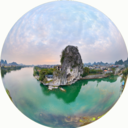0 Likes
The River Eisch, a serene tributary of the Alzette, winds its way gracefully through Luxembourg’s countryside, forming a natural border between the cantons of Mersch and Capellen near the quaint village of Dondelange. This area, steeped in pastoral beauty, is characterized by rolling hills, lush woodlands, and picturesque meadows that frame the river’s gentle flow.
Known locally as the "Valley of the Seven Castles," the Eisch valley is imbued with history and charm. Around Dondelange, the river meanders quietly, its clear waters reflecting the vibrant greenery of the surrounding landscape. Ancient trees line the riverbanks, their roots reaching into the cool, flowing water. Small wooden footbridges and well-trodden paths invite visitors to explore the tranquil surroundings, perfect for leisurely strolls or moments of quiet reflection.
The rural setting is rich in biodiversity, with kingfishers darting over the water and herons standing motionless in search of prey. The air is filled with the sound of rustling leaves and the occasional chirping of birds, creating a peaceful atmosphere.
This stretch of the River Eisch embodies the harmony between nature and history, offering a serene escape and a reminder of the enduring beauty of Luxembourg’s landscapes.





Europe is generally agreed to be the birthplace of western culture, including such legendary innovations as the democratic nation-state, football and tomato sauce.The word Europe comes from the Greek goddess Europa, who was kidnapped by Zeus and plunked down on the island of Crete. Europa gradually changed from referring to mainland Greece until it extended finally to include Norway and Russia.Don't be confused that Europe is called a continent without looking like an island, the way the other continents do. It's okay. The Ural mountains have steadily been there to divide Europe from Asia for the last 250 million years. Russia technically inhabits "Eurasia".Europe is presently uniting into one political and economic zone with a common currency called the Euro. The European Union originated in 1993 and is now composed of 27 member states. Its headquarters is in Brussels, Belgium.Do not confuse the EU with the Council of Europe, which has 47 member states and dates to 1949. These two bodies share the same flag, national anthem, and mission of integrating Europe. The headquarters of the Council are located in Strasbourg, France, and it is most famous for its European Court of Human Rights. In spite of these two bodies, there is still no single Constitution or set of laws applying to all the countries of Europe. Debate rages over the role of the EU in regards to national sovereignty. As of January 2009, the Lisbon Treaty is the closest thing to a European Constitution, yet it has not been approved by all the EU states. Text by Steve Smith.